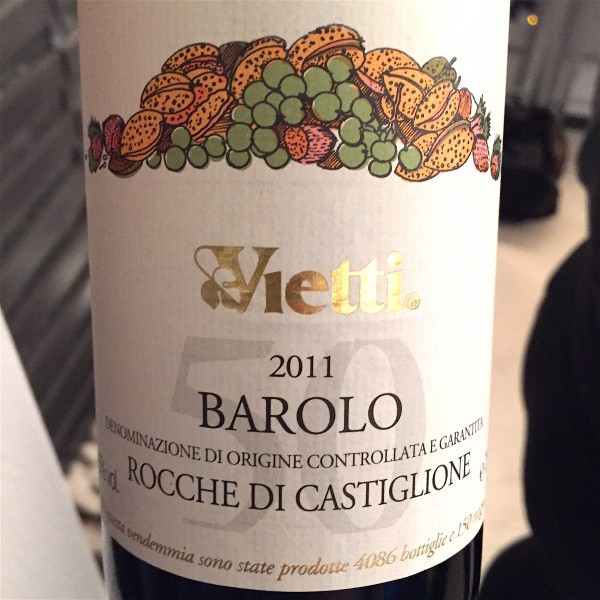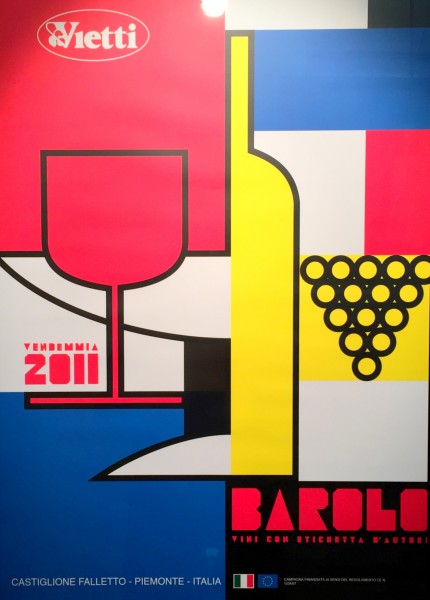Vietti Barolo Villero 2007–1996
Posted on 6 June 2015
What is it about Vietti? It is one of the superfamous wineries of Barolo (and Barbaresco), particularly renowned in America where much of the production is exported. Yet it is also a producer I could never really warm up, despite several interesting tastings in the past with the owner and winemaker, Luca Currado. So when I received the news Vietti were organising a vertical tasting of their top bottling, Barolo Riserva Villero, I jumped at the opportunity. Would I proven wrong on my lukewarmness to Vietti, and the wines, tasted in situ and in-depth, would thrill?
They did. This was certainly one of the highlights of this year’s Nebbiolo Prima. Not often do you have ten $100 bottles of Barolo on the table, including the now extremely limited older vintages of Villero. We actually started off with a „horizontal” tasting of Vietti Barolos from the 2011 vintage—highly acclaimed already even tough the wines are in their absolute youth. And I recommend holding on those Vietti bottles at least for 4–5 years; none of the 2011s I tasted here would remotely give much drinking pleasure before that. The 2011 Barolo Castiglione (equivalent to a village bottling) has moderate perfume with notes of pepper and spices; it then follows with little of the acidic vibrancy you expect from a young Nebbiolo (but 2011 is a ripe vintage). The Brunate comes across as fresher, with integrated oak, but still drowned in a sea of punitively thick tannins; coming from the zone of La Morra and Barolo town, this is one of tightest wines I tasted from this usually more approachable section of the appellation. The Lazzarito, from lighter, poorer soils, is more mineral in expression and almost citrusy-bright, with less imposing tannins, but it is not exactly fruity. 2011 Ravera (a recent addition to the Vietti range) is more approachable, with appetising black fruits and true elegance; I was not so impressed with the 2010 but in this vintage, it is a truly exciting wine. The best of these 2011s today is definitely the Rocche di Castiglione, meaty and savoury not unlike a red Douro wine, (the old vine extract is almost palpable) but also rich black fruits, and more polished tannins. This is a lovely 2011, one of the best I tasted this month (and I tasted hundreds).
We also tasted all the above crus in the 2012 vintage. They were barrel samples and I’d rather not publish full notes on these, but the impression is of another impressive vintage, if perhaps a bit leaner and more sinewy than 2011; they might take even longer to unfold.
On to the Villeros. This Riserva is a very limited wine: coming from 0.6 ha of now 40-year-old wines, it has only been released six times in the last 20 years, wth an average of 3500 bottles. (The production might increase after Vietti bought a small parcel of Villero from Oddero in 2014). The current release is the 2007. It is an obviously serious wine, quite different from the above 2010s, very tight and fine-grained, inky in the aromatics, with drops of forest fruits and cocoa pod essence. There is a sense of place, with an obvious cooling mineral effect. Despite the sheer weight and tannic tightness, this is impressive juice. But I was even more impressed by the 2006. Now 2006 Barolo Riservas are a pending topic—although they have been on the market for two years now, most are still way too young. This one too, but it already makes a major, 95-point impression: a little cooler and more mentholly in the aroma than the 2007, as impressively thick-grained, it will a magisterial Barolo 15 years down the line.
2004 also showed well, but it is not on the same level. Fatter and oilier, it has less minerality and freshness, and misses the train to greatness—perhaps typically of 2004 as a vintage, as I wrote here in my overview of the vintage after a ten-years-on retrospective. But 2004 was still more exciting than the trio of earlier vintages, including the underwhelming 2001, of which I expected more. A little green, a little tree bark-bitterish, this came across as quite dialectic: perhaps between ages, as Luca Currado said „it is usually one of the best” (as you’d expect from the vintage). 1997 Villero Riserva showed notes of evolution (though not fully mature), with a fat balsamic texture reminiscent of 2004 but the earthiness of 2001. Not a memorable bottle. 1996 Villero Riserva again had that dryness of tree bark, with olive oil and olive leaf, a savoury meaty character, and a slowly maturing, elegant palate. Unlike many 1996s, this doesn’t have an aggressive acidic streak, but it also between ages now: having lost the primary fruit, it hasn’t yet fully developed a mature richness. But I also thought the winemaking is now more focused and balanced at Vietti than it was in 1996 or 2001; the wines are more concentrated (vines are ageing) but the tannins are also more polished and juicy. Vietti already has an enviable range (look at the scores he gets from The Wine Advocate or Galloni) but ultimately, I felt the best is yet to come here.
Disclosure: my trip to Piedmont including flights, accommodation, and wine tasting programme are sponsored by Albeisa, the local wineries’ association.




